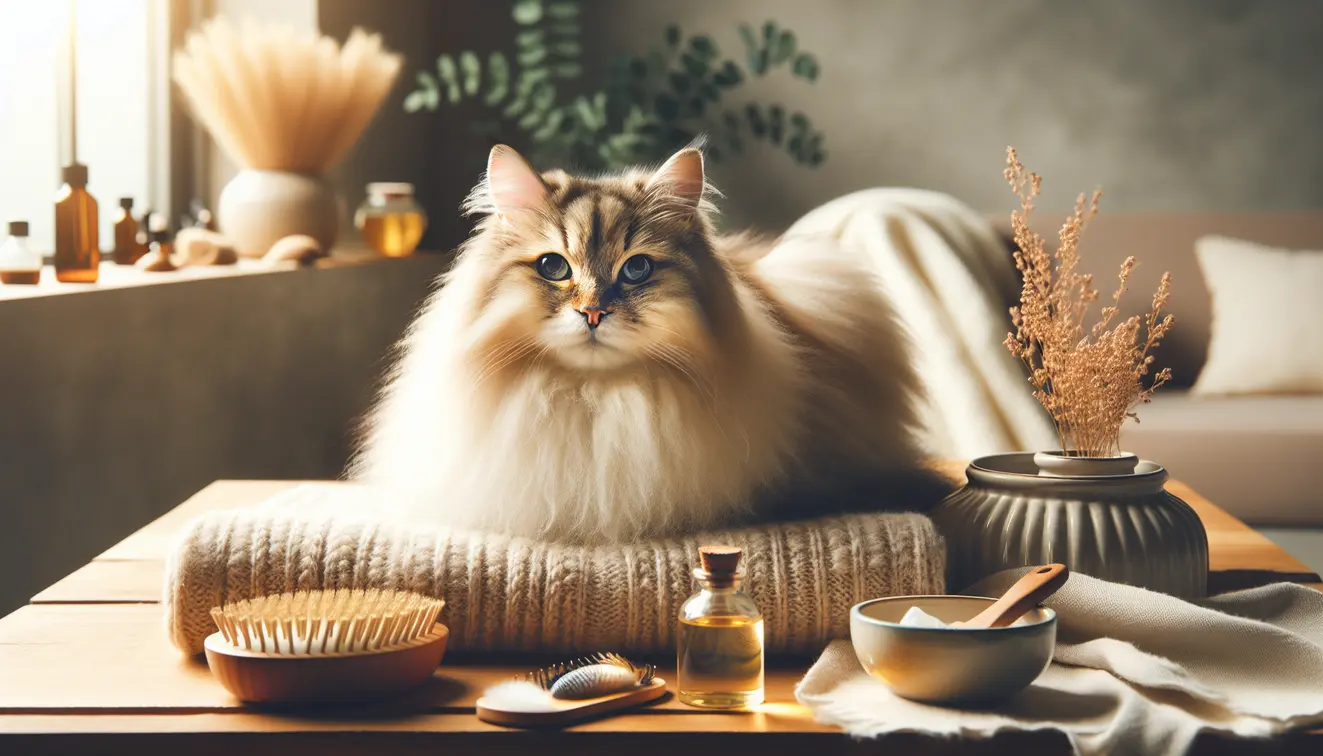Home Remedies For Cat Hair Loss: Safe & Natural Solutions for Your Furry Friend
Estimated reading time: 10 minutes
Key Takeaways
- Cat hair loss can stem from allergies, parasites, stress, diet, or medical issues.
- Natural remedies like dietary tweaks and coconut oil can help mild cases.
- Always monitor for worsening symptoms and seek vet care when needed.
- Preventative care through grooming and stress management supports long-term coat health.
Table of Contents
- Introduction to Cat Hair Loss Concerns
- Why Is My Cat Losing Hair? Understanding Common Causes
- When to Seek Veterinary Care for Cat Hair Loss
- Top Home Remedies for Cat Hair Loss: Natural and Safe Solutions
- Preventative Tips for Maintaining a Healthy Cat Coat
- Safety Precautions and Common Mistakes to Avoid
- Frequently Asked Questions (FAQs) on Cat Hair Loss
Introduction to Cat Hair Loss Concerns
Seeing your cat lose hair can tug at your heartstrings. It’s tough to watch your furry companion struggle with bald patches or thinning fur, and you’re likely eager to help. At Wiki Home Remedies, we understand this concern and are here to guide you with safe, natural solutions grounded in science for your pet’s well-being.
Hair loss in cats is more common than you might think. Studies from sources like the ASPCA show that many cats deal with this issue at some point in their lives. Whether it’s a small patch or widespread shedding, there are gentle ways to support your cat’s coat health.
Our mission is to empower you with trustworthy insights drawn from reputable research, including data from WHO, NIH, and PetMD. Before diving into remedies, it’s vital to grasp the reasons behind the hair loss. In severe cases, a vet visit is a must. Let’s explore the causes first to ensure we’re addressing the right problem.
Why Is My Cat Losing Hair? Understanding Common Causes
Noticing your cat’s fur thinning can be unsettling, but pinpointing the root cause is the first step to helping them. Hair loss isn’t just a cosmetic issue; it often signals something deeper, whether environmental, dietary, or health-related. Let’s break down the most frequent reasons behind this condition with clear insights to guide you.
- Allergies and Skin Reactions: Cats can develop sensitivities to food, pollen, or fleas, leading to relentless itching. This scratching often results in hair loss, especially around the neck or base of the tail. Look for redness or small scabs as telltale signs.
- Parasites like Fleas, Mites, and Ringworm: Tiny pests can wreak havoc on your cat’s skin. Fleas are a common culprit, with PetMD noting that up to 50% of cats with skin issues have flea allergies. Mites and ringworm also cause irritation, leaving bald spots.
- Stress and Behavioral Overgrooming: Cats sometimes lick or chew their fur excessively when anxious. This overgrooming strips away hair, often in symmetrical patterns. Changes in routine or environment can trigger this response.
- Dietary Deficiencies Affecting Coat Health: A lack of key nutrients like omega-3 fatty acids or protein can dull your cat’s coat and lead to shedding. Without proper nutrition, their skin barrier weakens. Check if their diet meets their needs.
- Underlying Medical Conditions: Hormonal imbalances or infections might be at play. Conditions like hyperthyroidism or bacterial infections can manifest as hair loss. If other symptoms like lethargy appear, don’t delay a vet check.
Understanding these triggers helps you decide the best course of action. Some issues need more than home care, and we’ll discuss when to seek professional help next to ensure your cat’s safety.
Allergies and Skin Reactions
Allergies can make your cat’s life uncomfortable, often leading to hair loss from constant scratching. Food sensitivities, particularly to chicken or grains, are frequent offenders. Environmental factors like dust or pollen also play a role, especially in cats with flea bite hypersensitivity.
Watch for signs beyond hair loss, such as inflamed skin or tiny sores. These reactions tend to focus on areas like the head or back. If you suspect an allergy, noting when symptoms worsen can help identify the source before trying dietary tweaks. For more insights on managing pet allergies, check out our guide on Home Remedies for Dog Allergies.
Parasites: Fleas, Mites, and Ringworm
Parasites are a sneaky cause of hair loss in cats. Fleas irritate the skin, leading to intense itching and bald patches, often near the tail. Mites burrow into the skin, causing scaly spots, while ringworm, a fungal infection, leaves circular hairless areas.
Check your cat for black specks of flea dirt or unusual crustiness. These pests spread fast, so early detection is key. While natural repellents can help, severe infestations often need veterinary treatment to fully resolve. Learn more about tackling fleas naturally with our post on Home Remedies for Dogs for Fleas. For insights on addressing ringworm, see our detailed guide on Home Remedies for Ringworm.
Stress and Behavioral Overgrooming
Cats feel stress just like we do, and some cope by overgrooming. This habit strips fur, often in neat patterns on the belly or legs, as they lick to self-soothe. Triggers can include a new pet, moving, or even loud noises.
Look for changes in their routine or mood alongside hair loss. Creating a calm space might ease their anxiety. We’ll share stress-relief tips later to help stop this cycle gently.
Dietary Deficiencies Affecting Coat Health
What your cat eats matters more than you might realize. Without enough omega-3s, protein, or vitamins like biotin, their coat loses its shine and strength. Hair falls out when the skin lacks nourishment, leaving patches behind.
Check their food label for balanced nutrients. If homemade meals are their diet, gaps might exist. Simple additions, which we’ll cover soon, can rebuild their fur from within.
Underlying Medical Conditions
Sometimes, hair loss points to a bigger health issue. Hormonal shifts, like those from thyroid problems, disrupt fur growth. Infections, whether bacterial or fungal, can also cause bald spots alongside symptoms like tiredness or appetite changes.
Never ignore persistent or worsening hair loss. Pair it with other odd behaviors, and it’s time for a vet. Ruling out these conditions ensures any remedy you try is safe.
When to Seek Veterinary Care for Cat Hair Loss
Your cat’s health comes first, and at Wiki Home Remedies, we prioritize their safety above all. While natural solutions can work wonders for mild hair loss, some signs scream for a vet’s expertise. Knowing when to act keeps your companion out of harm’s way.
Certain red flags shouldn’t be ignored. If you see large bald patches spreading fast, raw or bleeding skin, sudden weight loss, or a drop in energy, don’t wait. These could hint at infections or systemic issues needing immediate care, as noted by the American Veterinary Medical Association (AVMA).
Prepare for the visit by jotting down when the hair loss started and any diet or behavior shifts. Snap photos of affected areas to show the vet. This info helps them pinpoint the problem faster.
For milder cases, once serious conditions are ruled out, you can explore home remedies with peace of mind. Let’s dive into natural ways to nurture your cat’s coat back to health in the next section.
Top Home Remedies for Cat Hair Loss: Natural and Safe Solutions
You’ve likely identified a possible cause of your cat’s hair loss by now, and if it’s a mild issue, natural remedies can be a gentle starting point. At Wiki Home Remedies, we’ve gathered science-backed solutions to support your cat’s coat safely. Let’s walk through practical steps tailored to common triggers, always with caution in mind.
Dietary Adjustments for a Healthier Coat
What goes into your cat’s bowl can rebuild their fur from the inside. Lack of omega-3 fatty acids or protein often dulls their coat, so small tweaks work wonders. Here’s how to boost their nutrition safely.
- Add a vet-approved fish oil supplement to their meals. A dose of 250-500 mg daily for an average 10-pound (4.5 kg) cat supports skin health, per PetMD guidelines.
- Mix in a teaspoon of cooked, boneless salmon weekly for natural omega-3s. Ensure no seasoning or salt is added.
- Check their food for sufficient protein and vitamins like biotin. Switch to a high-quality, grain-free option if needed, after consulting your vet.
Start slow to avoid tummy upset and watch for improvements over a few weeks. A nourished body reflects in a shinier, fuller coat.
Natural Topical Treatments for Skin Health
Soothing irritated skin can halt hair loss caused by itching or dryness. Coconut oil stands out as a safe, natural option with moisturizing properties. Let’s apply it with care.
- Warm a small dab of virgin coconut oil, about a teaspoon, until it’s liquid.
- Test it on a tiny spot of your cat’s skin first to rule out sensitivity.
- Gently rub it into bald or dry patches, avoiding overuse as it can attract dirt.
Limit this to once or twice a week. Coconut oil hydrates without harsh chemicals, but stop if your cat licks excessively or shows discomfort. Always monitor their reaction. For more on using natural oils for pet skin issues, explore our article on Home Remedies for Dog Hot Spots.
Grooming Practices to Reduce Hair Loss
Regular grooming clears loose fur and boosts skin circulation, curbing excessive shedding. It’s a bonding moment too. Follow these steps for a gentle routine.
- Use a soft-bristled brush or grooming glove suited for cats. Tools like these reduce stress during brushing.
- Brush for 5-10 minutes daily, focusing on areas prone to matting or shedding.
- Check for skin redness or parasites while grooming, addressing issues early.
This habit prevents buildup that irritates skin. It ties directly to managing environmental or stress-related hair loss with a steady, caring touch.
Stress Reduction Techniques for Cats
If anxiety drives your cat to overgroom, creating a calm haven helps. Stress relief is often overlooked but vital for coat health. Try these ideas.
- Set up a quiet corner with their bed and familiar toys, away from noise.
- Use a pheromone diffuser, like those vet-recommended for calming, near their space.
- Spend extra time playing or cuddling to ease their nerves naturally.
Reducing tension stops the grooming cycle. Watch their behavior shift as they feel secure, preserving their fur over time.
Environmental Adjustments to Support Skin Health
Your home’s setup impacts your cat’s skin and fur more than you might guess. Dry air or pests can worsen hair loss. Make these changes with care.
- Place a humidifier in rooms where your cat rests to combat dry air, especially in winter. Aim for 30-50% humidity.
- Sprinkle food-grade diatomaceous earth on bedding to deter fleas naturally. Vacuum after 24 hours to avoid inhalation risks.
- Wash their bedding weekly in hot water to remove allergens or parasites.
These tweaks tackle external triggers like dryness or fleas. Pair them with other remedies for a holistic shield around your cat’s health. For additional tips on flea prevention, read our guide on Home Remedies for Fleas.
Preventative Tips for Maintaining a Healthy Cat Coat
Helping your cat recover from hair loss is just the start. Keeping their coat lush and strong long-term is the goal, and at Wiki Home Remedies, we believe in proactive care. Let’s explore lasting habits to guard against future shedding or skin woes.
Consistent Grooming Routines
A steady grooming schedule catches loose fur before it builds up. Spend a few minutes daily with a gentle brush to stimulate their skin. This keeps irritation at bay while strengthening your bond.
Nutrient-Rich Diets for Long-Term Coat Health
Fuel their body with the right foods from the get-go. Stick to high-quality cat food packed with omega-3s and protein, as Hill’s Pet suggests for coat health. A spoonful of safe supplements like fish oil can seal the deal if needed.
Stress Management for Overall Well-Being
Keep stress low with a stable routine and safe spaces. Playtime and quiet zones reduce anxiety that leads to overgrooming. A happy cat often means a healthy coat.
Seasonal Care Tips for Cats
Seasons shift, and so do your cat’s needs. In dry winter months, hydration and humidifiers prevent flaky skin. During heavy shedding in spring, more frequent brushing manages fur fallout naturally.
These steps build a foundation for wellness. By staying ahead of issues, you save your cat discomfort and keep their fur in top shape year-round.
Safety Precautions and Common Mistakes to Avoid
Exploring natural remedies feels empowering, but caution keeps your cat safe. At Wiki Home Remedies, we’re committed to guiding you responsibly. Let’s cover pitfalls to dodge and precautions to take while helping your furry friend.
Overdoing it with remedies can backfire. Too much coconut oil, for instance, might lead to greasy fur or digestive upset if licked in excess. Stick to small amounts and always patch-test new treatments on a tiny area first.
Human foods or products often harm cats. Chocolate, onions, or essential oils like tea tree are toxic, warns the ASPCA. Never assume something safe for you works for them—check with credible sources or your vet.
Ignoring your cat’s reactions is another slip-up. If they seem irritated or hair loss worsens after a remedy, stop immediately. Monitor closely for any odd behavior or skin changes.
Finally, don’t skip vet advice for stubborn issues. Home care complements but doesn’t replace professional insight for ongoing or severe cases. Prioritizing these safeguards ensures you nurture your cat without unintended harm.
Frequently Asked Questions (FAQs) on Cat Hair Loss
We know you might have lingering questions about your cat’s shedding. Here at Wiki Home Remedies, we’ve answered some common queries to ease your mind with clear, grounded insights.
Can stress cause hair loss in cats?
Yes, stress often leads to overgrooming, where cats lick away fur. Changes in environment or routine can trigger this. Creating calm spaces and steady schedules helps reduce anxiety.
What is overgrooming in cats?
Overgrooming happens when a cat excessively licks or chews their fur, often due to stress or allergies. It results in bald patches, usually on the belly or legs. Addressing the underlying cause is key.
What are safe natural oils for cat skin?
Coconut oil is a safe choice in moderation for moisturizing dry skin. Use just a small dab and ensure your cat doesn’t ingest too much. Always test for sensitivity first.
How does coconut oil compare to aloe vera for cat hair loss?
Coconut oil hydrates skin and is widely tolerated if used sparingly. Aloe vera, while soothing for humans, can be toxic to cats if licked. Stick to vet-safe options like coconut oil instead.
These answers aim to clear up doubts with practical advice. If more questions arise, pairing home care with professional input ensures your cat thrives. For related skin irritations in other pets, see our guide on Home Remedies for Dog Scratching.










